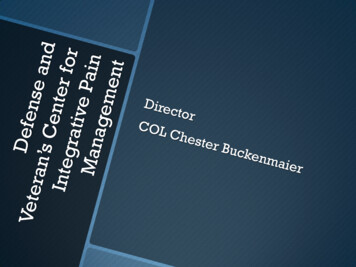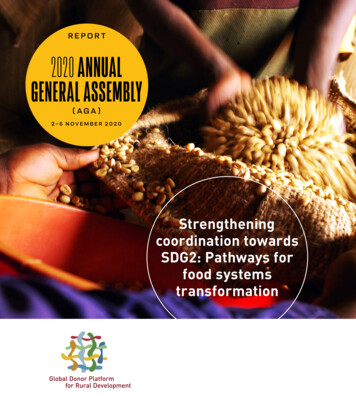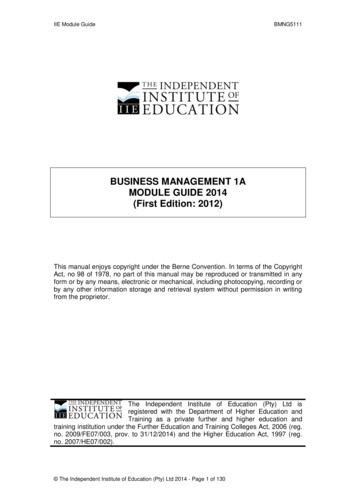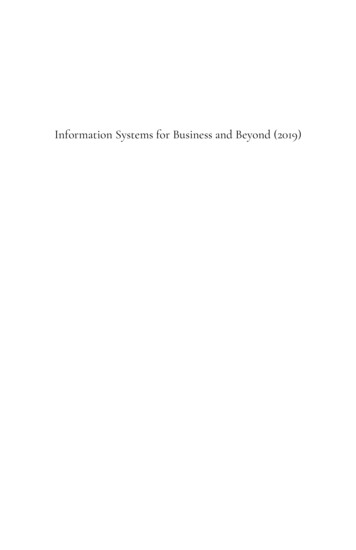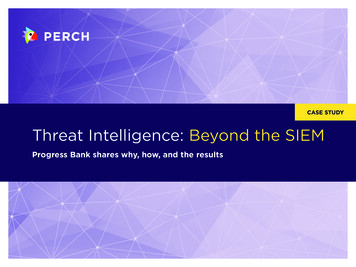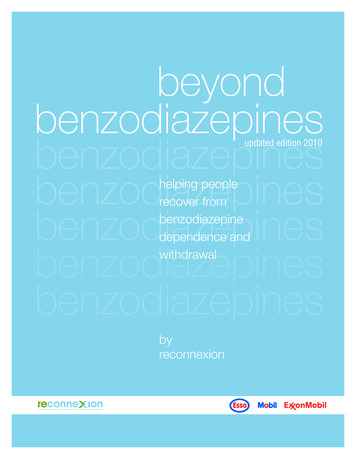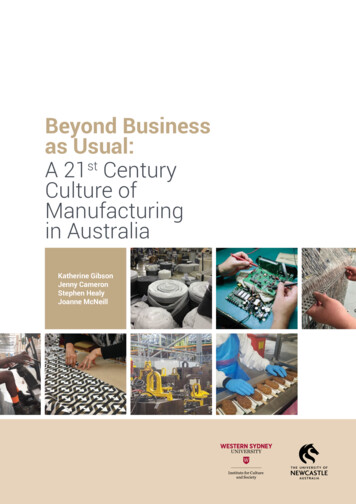
Transcription
Beyond Businessas Usual:A 21st CenturyCulture ofManufacturingin AustraliaKatherine GibsonJenny CameronStephen HealyJoanne McNeill
The Authors, December 2019Copyright statementThis publication is protected by copyright laws. Apart from any use permitted under theCopyright Act 1968, no part may be reproduced or altered by any process without priorwritten permission of the authors.For more information or to comment on this report, please contact:Professor Katherine GibsonInstitute for Culture and Society, Western Sydney UniversityLocked Bag 1797, Penrith, NSW 2751, e analysis presented in this document is that of the authors and does not necessarilyreflect that of the research participants.FundingThis research was funded by the Australian Government through the AustralianResearch Council’s Discovery Projects funding scheme (DP160101674). The researchteam acknowledges and thanks the ARC for its support of the project. The viewsexpressed herein are those of the authors and are not necessarily those of the AustralianGovernmentSuggested CitationGibson, K., Cameron, J., Healy, S. and McNeill, J., 2019, Beyond Business as Usual: A 21stCentury Culture of Manufacturing in Australia, Sydney, Australia: Institute for Culture andSociety, Western Sydney University.Published by:Institute for Culture and Society, Western Sydney University, Parramatta, NSW 2150ISBN 978-1-74108-500-6DOI 10.26183/5de4905d071df
Beyond Businessas Usual:A 21st CenturyCulture ofManufacturingin AustraliaKatherine GibsonJenny CameronStephen HealyJoanne McNeillDecember 2019
AcknowledgementsAbout the AuthorsThe research team would like to thank all the participants in thisstudy for their time, interest and frankness. We particularly thankthe ten manufacturing enterprises and their staff who so readilyengaged in the research process over the period 2016-2019:A.H. BeardInterfaceNCMC (Northern Co-operative Meat Company Ltd)NorcoOzGroupSebel FurnitureSoft LandingThe Social OutfitVarley GroupWorkVentures.Katherine Gibson is aProfessorial Research Fellowat the Institute for Cultureand Society, Western SydneyUniversity. She is an economicgeographer with an internationalreputation for pioneeringresearch on diverse economies.We also thank the international participants who generouslyprovided input:Altus Enterprises (NZ)Goods that Matter (USA)Innesto Cooperative (Italy)Interface (Netherlands)KOMOSIE (Belgium)Pocheco (France)Professor Vera Zemagni (Italy)Zero Waste Network (NZ).The research team also thanks colleagues and friends at theInstitute for Culture and Society, Western Sydney Universitywho provided administrative support for this project.Jenny Cameron acknowledges the generous support of hercolleagues and students in the Discipline of Geography andEnvironmental Studies at the University of Newcastle.Jenny Cameron is a ConjointAssociate Professor at theUniversity of Newcastle.Throughout her academiccareer she has researcheddiverse and communityeconomies, principally usingaction research methods.Stephen Healy is a SeniorResearch Fellow at the Institutefor Culture and Society,Western Sydney University.He has researched social andsolidarity economies during aresearch career that spans theUS and Australia.Joanne McNeill is the ResearchProject Manager for this project,and a Research Fellow with theInstitute for Culture and Society,Western Sydney University. Herresearch and prior professionalexperience engage with socialinnovation ecosystems andalternative economic organising.
ForewordIs there a future for manufacturing in an increasingly digital world? Will ‘generationnext’ recognise that a product is more than an app on a smart phone? As the internetof things becomes ubiquitous, who will make the things? These questions are timelyand relevant as Australia embarks on its post-mining boom transition to a moreinclusive and dynamic knowledge-based economy.Clearly manufacturing has a future in this new context, but it will be different fromanything and everything we have known in the past. The advance of robotics andautomation, nanomaterials and big data, and artificial intelligence and machinelearning, means that manufacturing requires more than ‘business as usual’. Itrequires the transformation of our entire industrial structure.The authors of this report understand the need for industrial transformation, butthey go further. They argue that manufacturing also contributes to social inclusionthrough the creation of high skill, high wage jobs. This is certainly the experience ofadvanced manufacturing economies like Switzerland and Germany. While automationdestroys some jobs, it also creates others, both within manufacturing enterprisesthemselves and in related services.Additionally, the authors identify the importance of manufacturing in addressingclimate change and environmental degradation. This is evident in the remarkablegrowth of renewable energy technologies and the application of manufacturingtechniques to improve energy productivity and sustainability. In this sense,manufacturing has become an ‘enabler’ of technological change and innovationacross industry boundaries as well as being an industry in its own right.The urgency of such change in Australia is highlighted by the Harvard Atlas ofEconomic Complexity which shows that we sustain our developed-world lifestylewith an ominously hollowed-out developing-world industrial structure. The atlasmeasures the research intensity and diversity of a country’s exports as a proxy forits innovation capability. Since Australia relies mostly on the export of unprocessedraw materials, we rank well behind the advanced economies with which we usuallybenchmark ourselves.Arguably, there was no obvious disadvantage in Australia’s export mix whilecommodity prices were high, and the boost to our terms of trade masked thedeterioration in our productivity performance. However, it has become apparent inthe wake of the mining boom that our future prosperity will depend increasingly onidentifying new sources of value in knowledge intensive goods and services.The importance of this report is that it explores the reinvention of manufacturing inAustralia from the viewpoint of developing a ‘manufacturing culture’. Only by doingso will we be able to build competitive advantage in global markets, and achievethe combined objectives of long-term economic growth, social inclusion andenvironmental sustainability.Emeritus Professor Roy GreenUniversity of Technology SydneyDecember 2019
Executive SummaryThere is a culture of manufacturing that is beyond business as usual in Australia.This report shows that there is a viable future for manufacturing in Australia in the 21st century that is beingshaped by a culture that is beyond business as usual. This report counters ill-founded fears that manufacturingin Australia is not viable by presenting convincing evidence of dynamic firms that are committed to just andsustainable manufacturing.In-depth qualitative research with 10 manufacturers based in NSW documents evidence of commitments to:1. Maintaining firm viability and thereby safeguarding manufacturing in Australia2. Providing decent jobs in an inclusive society and thereby building a more just manufacturing sector3. Producing with a smaller ecological footprint and thereby building a more environmentally sustainablemanufacturing sector.Manufacturing matters but it faces major challenges.Manufacturing supports 1.27 million jobs in Australia. It plays a major role in the social inclusion of people frommany different backgrounds and experiences. It is where the productive capacity of the society is nurtured. It is apoint of concentration for innovation and investment in R&D.But the business as usual model is no longer viable. Growth without regard for a social licence to produce is nolonger acceptable. Nor is growth with disregard for the environmental impacts of production and consumption.The new culture of manufacturing identified in this report is robust enough to meet the joint challenges ofincreasing inequality and environmental degradation.A beyond business as usual manufacturing culture is more than smart and more than green.This culture of manufacturing is ‘more than smart’. It situates the technological advancements associatedwith Industry 4.0 in the wider social context where concerns for good jobs are placed alongside the demand forgreater productivity and financial returns.This culture of manufacturing is ‘more than green’. It focuses on environmental sustainability at all stages ofthe production process and supply chain, as well as looking to the greenfield renewable energy sector and itsassociated new business opportunities.This culture of manufacturing combines production of material goods in a just and equitable manner with acontribution to social cohesion and with the minimisation of damage to supporting ecosystems.It is building viable firms with the capacity to withstand threats that might undermine the sector as a whole.In this culture of manufacturing, firms have a clear purpose and a long-term business horizon. This builds thecapacity to withstand undermining forces such as corporate raiding and the financialisation of the economy.It is helping Australia make progress on the Sustainable Development Goals (SDGs).The firms that are adopting a beyond business as usual approach demonstrate how manufacturers can lead theway in addressing:SDG 8 Decent Work and Economic GrowthSDG 9 Industry Innovation and InfrastructureSDG 12 Responsible Consumption and Production.Beyond Business as Usual: A 21st Century Culture of Manufacturing in Australia vii
ContentsAcknowledgementsivForewordvExecutive SummaryviiContentsviii1. Introduction11.1 Why Manufacturing in Australia Matters31.2 Challenges to Manufacturing31.3 Future Pathways41.4 What this Report Offers52. Research Method and Company Profiles62.1 Research Method62.2 Company Profiles10A.H. Beard10Interface12NCMC14Norco16OzGroup18Sebel Furniture20Soft Landing22The Social Outfit24Varley Group26WorkVentures283. Safeguarding Manufacturing303.1 Motivations that extend beyond profit31INSIGHTS: Business motivations beyond profit32SNAPSHOT: From shareholders to stakeholders343.2 Long term business horizons35SNAPSHOT: Interface – From Mission Zero to Climate Take Back36SNAPSHOT: WorkVentures – Growing seedlings into trees37SNAPSHOT: A.H. Beard – Risking all to save the firm38SNAPSHOT: Varley Group – Cutting back to save the business39SNAPSHOT: Norco – Resisting demutualisation40TM3.3 Thoughtful growth41INSIGHTS: Growth that serves multiple stakeholders42SNAPSHOT: Soft Landing – Growing and remaining ethical44viii Beyond Business as Usual: A 21st Century Culture of Manufacturing in Australia
SNAPSHOT: Sebel Furniture – Refocusing growth on what is core46 SNAPSHOT: NCMC, Norco and OzGroup – Thoughtful growth in aclimate changing world474. More Just Manufacturing494.1 Technological Change and Decent Jobs50SNAPSHOT: Norco – Introducing automation on the shopfloor51SNAPSHOT: Automation and jobs524.2 Workers as Valued Contributors53INSIGHTS: Workers as valued contributors54SNAPSHOT: Interface – Valuing workers in a crisis584.3 Factories as Sites of Inclusion59INSIGHTS: Factories as sites of inclusion60SNAPSHOT: New technologies, inequality and training655. More Sustainable Manufacturing5.1 Product as High Quality and Durable6768SNAPSHOT: Varley Group – High-quality and durable products69SNAPSHOT: Product-as-a-Service705.2 Efficiency as Waste ReductionSNAPSHOT: Sebel Furniture – Lean manufacturing as waste reduction5.3 Product Circularity717273SNAPSHOT: The Social Outfit – Extending the life cycle of fashion74 SNAPSHOT: WorkVentures – Extending the life cycle of electronicand IT equipment75SNAPSHOT: Interface – Extending the life cycle of carpet tiles76SNAPSHOT: Soft Landing Mattress Product Stewardship Scheme776. Recommendations for Manufacturing a Liveable Future78 6.1 Policy Directions for Safeguarding Manufacturing in Australia806.2 Policy Directions for Building a Just Manufacturing Sector83 6.3 Policy Directions for Building an Environmentally SustainableManufacturing Sector866.4 Conclusion91References92Appendix 1: A Public Declaration99Beyond Business as Usual: A 21st Century Culture of Manufacturing in Australia ix
1. IntroductionWith the closure of the last car assembly plants, doubts were raisedabout whether there would be a future for manufacturing in Australia.1Today many people are surprised to think that manufacturing in Australiamight be viable and that young people might expect an exciting futureworking in manufacturing.The research on which this report is based set out to answer thefollowing questions:What kind of future is there for manufacturing in Australia?How can manufacturing address the two 21st century challenges of:1. growing inequality and social exclusion2. environmental degradation?The combination of the Global Financial Crisis (GFC) and the climatecrisis means previously accepted ways of doing business have beencalled into question. It is now commonplace to hear that business asusual cannot continue and that new ways of doing business are needed.This report presents compelling evidence that there is a just andsustainable future for manufacturing in 21st century Australia. Indeed,the future is already here in the form of a manufacturing culture that isbeyond business as usual. But this manufacturing culture is not wellknown or publicly visible.As two of the manufacturers in this research commented:There’s a view that we don’t make anything in Australia anymore –full stop. So people are staggered when I say to them, ‘I’m a carpetmanufacturer.’ They say, ‘Oh, you mean you sell some stuff youimport from overseas?’ I say, ‘No, we make it here in Sydney.’ Andthey go, ‘Oh, that’s astounding. I didn’t think we did anything like thatanymore.’ Manufacturing’s not as visible as it used to be. It doesn’thave big smoke stacks and big industrial sites and people with picketsoutside anymore. When you get in there it’s invariably clean and smartand clever it’s no longer the Dickensian sawtooth roof with steambelching out of pipes.Managing Director, Australia and New Zealand, InterfaceMindshop arrange for year 12 students from local high schools to workon a challenge within a business and provide a solution. This is part oftheir year 12 assessment. Students from Menai High School worked withthe A.H. Beard business and on completion of their project, teachersand parents were invited to attend a student presentation. They wereastonished that although we are a manufacturing facility, the careeropportunities are many and varied. We have roles in marketing, media,education, procurement, sales, customer service and finance as wellas operations and logistics. Many people view manufacturing asblue-collar workers on a factory floor. I feel the Australian governmentneeds to consider Australian manufacturing and the careeropportunities they provide for our young people and the developmentof our country into the future.Education and Development Manager, A.H. Beard1For example, Eltham, 2014; Ladd, 2017;Taylor et al., 2014.Beyond Business as Usual: A 21st Century Culture of Manufacturing in Australia 1
Manufacturing is rarely discussed in cultural terms. Yet the tenmanufacturing firms involved in this research all referred to theirdistinctive ‘culture’ of operation. They articulated distinctivecommitments that indicate a culture that is beyond what is associatedwith business as usual.These firm level commitments shape day-to-day practices. Together,the commitments and practices comprise a nascent culture ofmanufacturing, one that transcends individual firms and has thepotential to shape the sector as a whole.This culture is making a vital contribution to the nation by:1. Maintaining firm viability and thereby safeguarding manufacturingin Australia2. Providing decent jobs in an inclusive society and thereby building amore just manufacturing sector3. Producing with a smaller ecological footprint and thereby building amore environmentally sustainable manufacturing sector.Beyond Business as UsualA 21 Century Culture of Manufacturing in AustraliastSafeguarding manufacturing in AustraliaCommitments1. Motivations that extend beyond profit2. Long term business horizons Practices3. Thoughtful growthBuilding a just manufacturing sectorCommitments1. Technological change and decent jobs2. Workers as valued contributors Practices3. Factories as sites of inclusionBuilding an environmentally sustainable manufacturing sectorCommitments1. Product as high quality and durable2. Efficiency as waste reduction Practices3. Product circularityThis introduction sets the scene by providing background informationon manufacturing in Australia, identifying the challenges manufacturingfaces, and overviewing the types of recommendations that have been putforward in recent reports to secure Australia’s manufacturing future. Theintroduction ends by identifying what is distinctive about this report.2 Beyond Business as Usual: A 21st Century Culture of Manufacturing in Australia
Section 2 explains how the research was conducted. It includes anoverview of the qualitative research method and Company Profiles forthe ten manufacturing firms that were studied.The next sections are organised around the three vital contributions thatmanufacturing can make to this nation:Section 3: Safeguarding manufacturingSection 4: Building a just manufacturing sector Section 5: Building an environmentally sustainablemanufacturing sector.Each section discusses the commitments and practices associated withthese contributions.Section 6 concludes with recommendations for policy directions,organised in terms of their match with three of the United Nation’sSustainable Development Goals.1.1 Why Manufacturing in Australia MattersManufacturing remains a significant activity in Australia’s economy. Itsupports 1.27 million jobs.2 The employment numbers directly attributedto the manufacturing sector remain substantial (840,325 at end of June2018).3 The sector continues to demonstrate good prospects in terms ofjob quality, stability and wages.4Australian manufacturing has seen a steady rise in output over the pasthalf century, representing a dramatic increase in productivity. In 2014/15it was the largest contributor by sector to business expenditure onresearch and development.5A robust manufacturing sector has inherent value because it offerspractical hands-on problem-solving work (both unskilled and skilled)that further builds up the industrial know-how of society. In Australia,manufacturing has long played a role in building social cohesion byintegrating overseas migrants and young people into worksites wherenew skills and habits are learnt on the job.1.2 Challenges to ManufacturingThe economic challenge: There is no doubt that manufacturing inAustralia faces many economic challenges.6 As a developed nationthat places value on good workplace relations and regulated standards,Australia is regularly positioned as a ‘high cost’ operating environment.7Transport costs both internally and externally are seen to be high.Currency fluctuations can drastically affect input costs and destabiliseforward projections. Its relatively small domestic market and distancefrom mass global markets influence the potential for growth.The social challenge: The image of manufacturing offering a fair go forall Australians is less prevalent today. In recent decades, the distributionof wealth and economic wellbeing to which manufacturing once majorlycontributed has stalled and there is growing income inequality in manyeconomies, including Australia.82Advanced Manufacturing Growth Centre Ltd2017, p. 11. This number is based on jobsdirectly classified as manufacturing and jobsthat are outside manufacturing but providingdirect inputs to manufacturing These latter jobsinclude 53,000 jobs in professional services, aswell as jobs in areas such as agriculture, mining,and transport and warehousing.3Australian Bureau of Statistics 2018. In the1960s, manufacturing in Australia employedover 1.2 million people (or just over one-quarterof the workforce), see Clark et al. 1996; Connolly& Lewis 2010.4For example, as identified by Stanford & Swann(2017, p.8), part-time work in manufacturingis half that in the labour market as a whole;minimum wage compensation is smallerproportionately; and average weekly earningsare about ten percent higher than in theeconomy as a whole.5Australian Government 2017, pp.77-78;Australian Government 2019.6For example, see Green & Roos 2012; Ranu 20177Sirkin et al. 2014.Picketty 2014, pp.246-250. Indeed, in recentyears, international institutions such as theInternational Monetary Fund have becomeincreasingly concerned about the negativeconsequences of increasing levels of inequality.8Beyond Business as Usual: A 21st Century Culture of Manufacturing in Australia 3
The environmental challenge: Today the world is poised on the brinkof an environmental crisis that has the potential to threaten thelivelihoods and security of millions around the world. Manufacturingand the burgeoning consumption habits of a growing world populationare implicated in the Great Acceleration of economic growth andenvironmental degradation that has taken place since the 1950s.9What and how we produce the stuff of life is now under examination.A loss of confidence in business: Since the GFC there has been continuedrevelations of the irresponsibility of some business leaders. There isample evidence that the ‘greed is good’ mantra—whether in high profilefinancial institutions, retailers, miners or manufacturers—has erodedthe public’s confidence.10 Business as usual has become associatedwith profit making at all cost, short term gains on the stock market, alack of commitment to communities and regions and profligate use ofpristine resources without concern for wastage or product ‘end of life’.Plausible counter stories are needed to restore confidence that businessin Australia can do better.Amidst the noise of media and research reports that focus on challengesto the Australian manufacturing sector, this report provides insights intothe following concerns:1. How are manufacturers meeting these challenges of the 21st century?2. How are they challenging stereotypes?1.3 Future PathwaysThe Australian public has become used to hearing that what stands inthe way of a more viable manufacturing sector is a business culture thatis not sufficiently innovative and labour relations that are too combative.Research and debate often centre on how Australian manufacturingcan ‘get competitive’.11Two pathways to competitive success are currently being advocated viathe promotion of: 1) Industry 4.0 also known as ‘advanced manufacturing’ or ‘smartmanufacturing’ based on new technologies that bridge the physicaland digital worlds12 2) a Green New Deal, which refers to a renewables-led transformationof the economy.139Steffan et al. 2015.The recent Australia Talks National Surveyconducted in July 2019 by the ABC of morethan 54,000 Australians found that corporateexecutives were the third least trustedprofession (with politicians and celebrities theleast trusted). See ions-australianstrust-the-most/11725448.10For example, see Australian Government2014, p.77.11See industry-40.1213For example, see Ireland 2019; Murphy 2019.14See Friedman 2019.The Industry 4.0 revolution emphasises the introduction of automatedtechnologies that will transform product design, production, processesof communication with clients and overall management. Robotics, smartsensors, big data analytics, customer profiling, and the Internet of Thingsare all part of this contemporary industrial revolution.The Green New Deal sees the development of renewable energy asleading a widespread transition to green jobs away from jobs tied tofossil fuels. The shift to renewables will prompt new high-tech industries,distributed around the country and no longer tied to centralised energygrids. In the US, the Green New Deal is also focused on addressing racialand environmental inequities.14 In Australia, it is informing discussion ofalternative industry policy within the Federal Opposition and the Greens.Both these pathways largely focus on the things that manufacturersand governments could and should be doing in order to reach thisyet to be realised future. As well, the future that is projected is onein which technological advancements do the heavy lifting ofeconomic transformation.4 Beyond Business as Usual: A 21st Century Culture of Manufacturing in Australia
A potential (but not insurmountable) problem with these popular andheralded pathways is that they do not challenge the business as usualmodel. The culture of manufacturing remains focused on being at thecompetitive edge, ahead of the game.Another is that they ignore what is at hand. That is, they overlook theways that existing companies are already practising advanced (and just)and green (and sustainable) forms of manufacturing.This report showcases a range of enterprises that are responsiblyproducing goods essential to material wellbeing and comfort. Wedocument their pathways to success as a contribution to widening thedebate about what manufacturing futures could be.1.4 What this Report OffersThis report has three distinguishing features.First, it is based on in-depth qualitative research with ten manufacturersusing what is called a strengths-based approach.15 This means theresearch sought to find what it is that manufacturers are already doing tobuild a viable, just and sustainable manufacturing sector that will meetthe challenges of the 21st century.Second, this report is based on the idea that there are manufacturingcultures. This means that manufacturing is understood as entailing waysof thinking (commitments) and doing (practices). As a culture, thesecommitments and practices are also entangled with standards, normsand rules informed by shared values. Mostly, a culture goes unremarked,until called into question, often when there is a crisis. The questioning ofbusiness as usual was prompted by the Global Financial Crisis and theclimate crisis.Third, the project took as one line of inquiry the differences thatenterprise ‘type’, in terms of ownership and governance structure, mighthave on manufacturing commitments and practices. The businessas usual mode of operation is largely associated with an ideal type of‘capitalist’ enterprise, one that is animated by profit-making, competitivegrowth and the private accumulation of wealth. This study incorporated arange of enterprise types (as discussed more in Section 2.1).By using a strengths-based approach to study public, private and familyowned companies, as well as co-operatives and social enterprises, allengaged in manufacturing, this research has produced new findingsabout a culture of manufacturing beyond business as usual.A strengths-based approach seeks out theassets and capacities of individuals, communitiesor, in this case, enterprises. While not ignoringneeds and deficiencies, this approach doesnot dwell on them as this stokes a negativeaffect that undermines the incentive for creativeaction. The authors of this report have used thisasset-based approach, as originally developedby Kretzmann and McKnight (1993), in manyof their action research projects (for example,Mathie et al. 2017).15Beyond Business as Usual: A 21st Century Culture of Manufacturing in Australia 5
2. Research Method andCompany ProfilesIn order to explore the strengths of manufacturing in Australia, theresearch used an in-depth qualitative approach based on interviewsand site visits with ten manufacturers. This section provides moreinformation about how the research was conducted, how the resultingdata were analysed and how it is presented in this report. This sectionalso introduces the ten manufacturers, providing an overview of theiroperations and important background on their historical development.2.1 Research MethodParticipating manufacturers were recruited on the basis of documentedreputation, recommendations from industry experts and snowballsampling. The selection aimed to secure a range of different types ofmanufacturers, in terms of products, age, size, market reach and scale ofsupply chains. Table 2.1 overviews the range of manufacturers.Table 2.1 The Range of ManufacturersProducts Blueberries and PackagingCarpet TilesDairy Products Electronics and IT Repair, Refurbishmentand RecyclingFabricated Metal ProductsFashionFurnitureMattressesMattress RecyclingMeat ProductsAgeFrom 5 years to 133 yearsSizeFrom four to over 1,000 staffMarketsLocal, national and internationalSupply ChainsFrom local to global supply chainsAs the research team was based in New South Wales (in Sydneyand Newcastle), there was a focus on firms operating in NSW. Someof the firms have manufacturing operations only in NSW and somemanufacture in other states and in other countries. It should be notedthat NSW contains nearly 30 per cent of Australia’s direct manufacturingworkforce, with Food manufacturing far outstripping other product areasin terms of numbers employed (followed by Fabricated Metal Productsand Other Machinery).1616NSW Department of Industry 2018, pp. 8 & 9.Different enterprise types were recruited to encompass different waysof making decisions and conducting business, and to see whether andhow these varied approaches to business contributed to ways of ‘doingmanufacturing’. Table 2.2 identifies the enterprise types included in thestudy and locates the ten manufacturers in terms of their enterprise type.6 Beyond Business as Usual: A 21st Century Culture of Manufacturing in Australia
Table 2.2. Diverse Enterprise TypesPublic companyPublic companies have shares that are traded on t
The firms that are adopting a beyond business as usual approach demonstrate how manufacturers can lead the way in addressing: SDG 8 Decent Work and Economic Growth SDG 9 Industry Innovation and Infrastructure SDG 12 Responsible Consumption and Production. Beyond Business as Usual: A 21st Century Culture of Manufacturing in Australia vii



